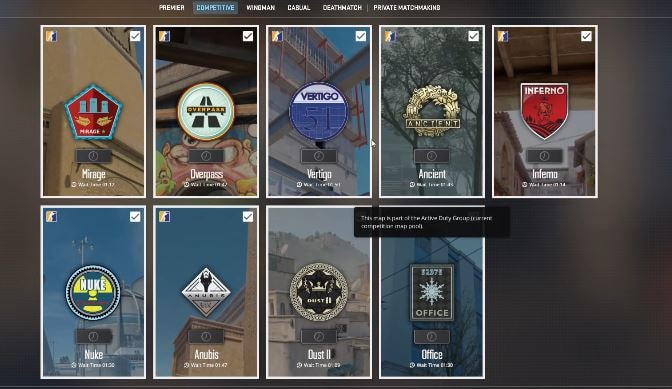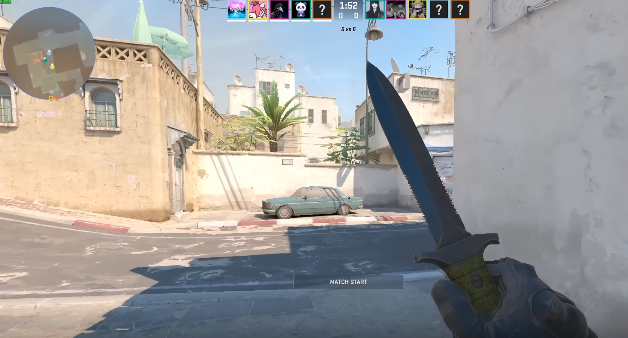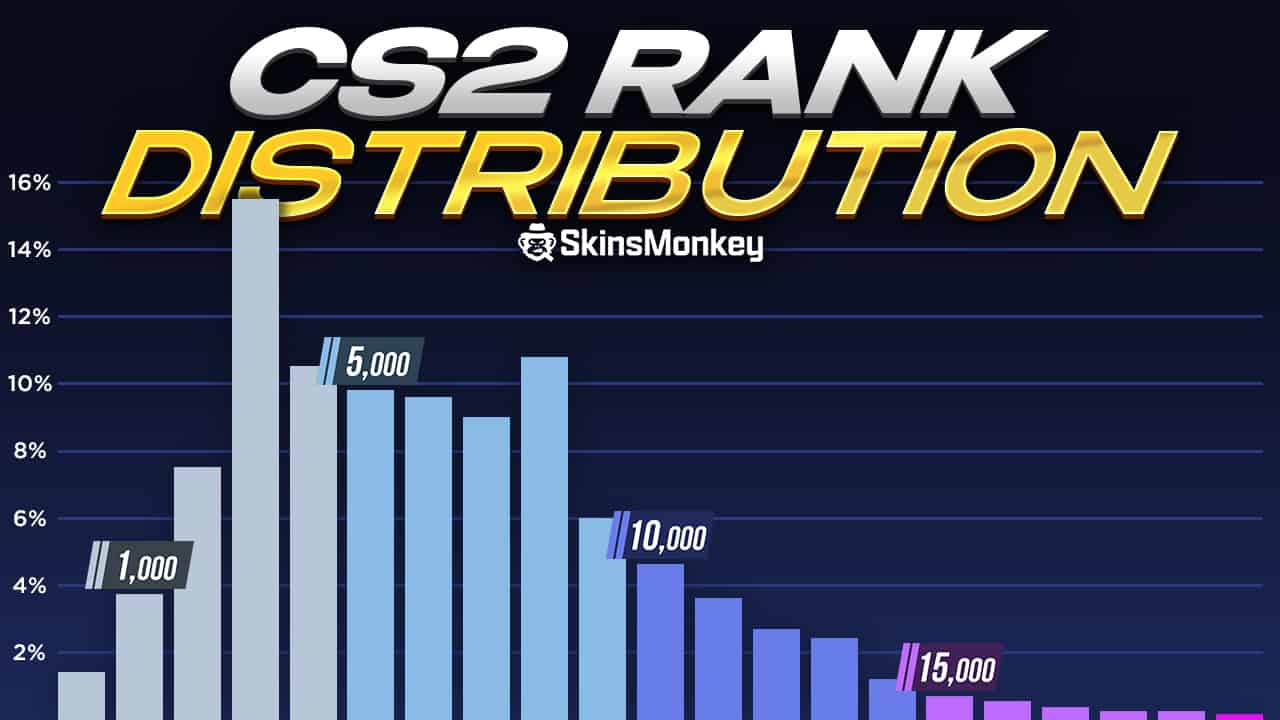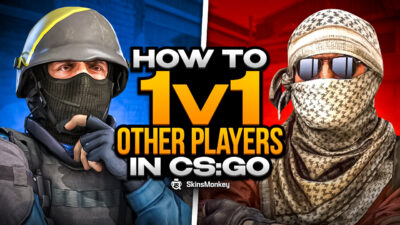The ranked mode is what brings most players to the game. The Counter-Strike franchise has been known primarily as a competitive game ever since its inception, with its ranking systems being a core feature. With quick rounds that allow for fast-paced gameplay and players to show off their skills, aim is a fundamental skill in CS2 and is crucial for success in ranked play. Counter-Strike is one of the leaders in the genre of competitive games, as well as one of the most popular eSports games in the world of competitive gaming.
The game uses competitive ranks to ensure fair matchmaking and to provide players with a clear progression path based on their skill level. The game uses a ranking system, which evaluates each player’s individual skill level and places them in one of the different brackets within the CS community. The gaming environment in CS2 challenges players to constantly improve and adapt their strategies. If you’re ready to take on the challenge, join the CS2 ranking system and test your abilities against others.
So, what are the CS2 ranks you can score? Here’s everything you need to know about CS2 ranks and rating system!
Also, make sure to check out the rest of our website, where you can trade CS2 skins for the best prices available.
Key takeaways:
- CS2 features a ranked system, where players can test their skill in a competitive environment.
- The game has two separate ranked modes: Competitive and Premier, both with their separate CS2 rank system.
- The competitive mode CS2 ranks in are:
- Silver
- Gold Nova
- Master Guardian
- Legendary Eagle and Legendary Eagle Master
- Supreme Master First Class
- The Global Elite
- Players can follow a course of improvement to climb the ranks.
Did CS2 Change The Ranking System?
One of the biggest changes introduced with the CS2 update was the new ranking systems, which split the competitive mode and premier mode into essentially two different ranked queues, with separate ranks. The key difference between these two modes is that in premier mode, your rank is visible as a CS rating and is tied to your performance across all maps, while in competitive mode, your rank is map-specific and not shown on the global leaderboard.
The premier mode, however, is a new feature added to the Counter-Strike matchmaking within CS2, and is more similar to the older ranked mode. Unlike the competitive mode, when queuing up for a new game in the premier mode, you don’t select a single map, but instead queue for a pool of all the current active duty maps, and end up drafting the final pool through a series of bans with other players in the match. Over time, Valve has made small adjustments to the ranking algorithms in premier mode, gradually refining how player skill is measured and categorized.
When it comes to the CS rating system for the new premier mode, there’s only a single pool for the entire player base, meaning that the premier mode rank is a better reflection of the player’s general skill. Players can expect a more transparent and competitive progression, with their rank more closely tied to overall performance rather than individual map results.
In the premier mode, players get an ELO number instead of a specific rank. However, each ELO number has a corresponding rank color. At each point where a player crosses into a new color range, it marks a milestone in their ranking progression. These colors are:
- 0 – 4,999 – Gray
- 5000 – 9999 – Light Blue
- 10000 – 14999 – Blue
- 15000 – 19999 – Purple
- 20000 – 24999 – Fuchsia
- 25000 – 29999 – Red
- 30000+ – Gold
Players can improve their premier rating by winning matches, and consequently fall down in the rankings and lose elo points for their poor performance.
Need to make some quick cash? Check out our guide on how to sell CS2 skins for real money!
Competitive Ranks

The competitive mode uses a rating system similar to the old version of CSGO, just with one individual rating for each map.
The classic competitive mode features traditional ranks ranging from Silver to Global Elite, familiar to players transitioning from CS: GO. These are:
- Silver (I to IV, Silver Elite and Silver Elite Master) — with Silver IV being the highest in the Silver group
- Gold Nova (I to III and Gold Nova Master)
- Master Guardian (I, II, Master Guardian Elite and Distinguished Master Guardian)
- Legendary Eagle and Legendary Eagle Master
- Supreme Master First Class
- The Global Elite (the highest rank in the system)
Players who are familiar with how CS:GO ranks worked in the previous iteration of the game will easily understand what each of the competitive ranks means. The majority of players are typically found in the Silver and Gold Nova ranks, reflecting the overall distribution.
Players at the Master Guardian level possess significant experience and advanced game mechanics, positioning them just below the professional tier. The number of games played is a key factor in reaching higher ranks, as consistent participation helps improve skills and stats. Reaching the Master Guardian Elite rank is an impressive milestone as well, often motivating players to consider advancing towards the CS2 pro scene.
The Supreme Master rank is just below Global Elite, requiring not only skill but also support and luck to reach. The Supreme Master First Class rank represents the peak of player skill, with factors like luck and community support playing a crucial role in achieving it. The Global Elite rank remains the highest rank a player can attain, symbolizing exceptional skill and dedication. Keep in mind, however, that even some of the pros don’t have the Global Elite in their CS profile.
To move up in ranks, players need to secure a win in matches, as victories directly impact their matchmaking rating. Hitting a new rank is a significant accomplishment, and tracking your progress can be highly motivating. Monitoring stats such as win/loss ratio also helps players identify areas for improvement and move up the competitive ladder.
Read also: Best M4A4 Skins
Why Are There Two Ranking Systems in CS2?

Although the change might’ve been surprising, it certainly helped bring Counter-Strike to modern standards. Although the ranks in Counter-Strike: Global Offensive were a signature of the genre, it also created an extremely competitive environment, as well as a community that at times could be very toxic, particularly at higher ranks, where there was a lot at stake in every competitive match. Playing competitive matches is crucial for ranking progression, as each game provides an opportunity to improve performance and climb the ranks. Players are initially placed based on their performance in matchmaking games, which determine their starting rank and set the stage for their journey.
With the separation into competitive and premier, casual players, as well as those who are looking for a more hardcore ranked experience, will have a choice of what they want to play. Really dedicated players can now grind out their tournament ranks in CS2 Premier, where such players will definitely enjoy the ability to show off their map knowledge and skill against other hardcore gamers and outplay their opponents. For new players, the ranking system provides a structured path to progress and learn the game, though it can be challenging to adapt at first.
Also check out: Best CS2 console commands
How to Improve Your CS2 Rank?
Toxic environments can be discouraging, but playing with teammates, a team, or friends can greatly improve communication, foster better teamwork, and reduce toxicity. Finding teammates who share similar goals and a positive attitude is essential for ranking up efficiently and enjoying the game. After losing a match, it's important to take a break, analyze your performance, and avoid jumping straight into the next game. This helps maintain focus and prepares you mentally for your next game, increasing your chances of success.
To improve your skills and rank up, regular practice is key. Utilize retake servers, a deathmatch server, and play aim maps to enhance your aiming, tactics, and overall gameplay. These practice environments are especially helpful for both new players and experienced competitors looking to maintain or elevate their rank.
If you want to learn more about ranked CS2, make sure you check out this guide by louiecs2:
When Do You Get The First Rank In CS2?
In both of the ranking systems you first need to complete ten placement matches to get your first rank. Watching demos is arguably one of the most effective ways to improve your gameplay and secure a better placement. After you complete your set of placement matches, you’ll receive a rank based on your performance. Keep in mind, that if you already had a CS rating in the past, the new one you’ll receive isn’t going to be radically different from what you had before. This means that you won’t be able to make an instant jump from Silver Elite Master to Global Elite.
Check out also: What are the cheapest CS2 gloves?
When Do CS2 Ranks Reset?
Your CS rank will reset if you don't play for a prolonged time. In order to maintain your CS2 rank you need to play at least a single match every two weeks. If you remain inactive in the ranked mode for a longer period of time, you might have to re-play your placement matches, as your CS rating decays over time.
In addition, your CS2 rank resets at the start of each premier season. This means that once the new season starts, you will have to re-play your calibration matches. While you might get a different CS2 rank this way, your final standing after the recalibration won't be that much different from your last season's.
Also read: Best M9 Bayonet Skins
What Is The CS2 Rank Distribution?
Currently, the percentage for each skill level in premier mode is:
- 5% – Gray
- 32% – Light Blue
- 40% – Blue
- 16% – Purple
- 4% – Fuchsia
- 3% – Red
- 0.0001% – Gold
As you can see, most players are around the Blue and Light Blue ranks, which are the CS2 versions of gold nova master and gold nova from the previous game, meaning that on the average rank distributions remain somewhat similar to CSGO.
However, the tiny percentage of Gold player base shows, that it’s harder to reach the higher levels of CS2 rank distribution. The Gold rank is a new take on the Legendary Eagle from the previous game, however, it seems that reaching it is more difficult within the CS2 community.
Also check out: Butterfly Knife Cases
What CS2 Ranks Can Play Together?
If you want to play ranked CS2 with your friends, you have to keep in mind what CS2 ranks can play together. Since Valve wants to fight CS2 smurfing, all players in a ranked match have to be on the same, or similar, skill level to keep things fair.
While you can play with your friends who have higher or lower ranks, keep in mind, that there are some limitations as to what CS2 ranks can play together:
- For the competitive mode, all players within the match have to be at least five ranks from each other.
- In the premier mode the CS ratings of all players have to be 5000 from each other or lower.
If you queue for a match with your friends who have different ranks and skill levels, the match will be balanced accordingly, and you can expect the other team to include a similar set up as well.
Also read: Best Butterfly Knife skins
In Conclusion
Here's the rank distribution in CS2 for April 2024. Although these numbers might be subject to change in the future, considering how the game has been out for a couple of months now, it's safe to say that the community has a rough idea regarding how the ranks are spread over the game.
If you enjoyed this article, make sure to check out the rest of our blog, where we regularly post more tips, tricks, CS2 news, and even offer free CS skins giveaways!
Also, if you liked this article, make sure you check out our other posts, including:
- Best CS2 cases
- Best cheap CS2 Skins
- Karambit Blue Gem Guide
- All Karambit CS2 Cases
- Cheapest AK-47 Skins
FAQ
CS2 has two ranking systems: Competitive ranks like Silver and Global Elite, and Premier mode, where your skill is shown as a CS Rating with color tiers.
In Premier, you get a CS Rating that goes up or down based on your wins. In Competitive, you have a separate rank for each map. Winning games helps you rank up.
In Competitive, you can queue with friends within five ranks. In Premier, you can play together if your CS Ratings are within 5,000 points.
Ranks reset at the start of each Premier season or if you don’t play for two weeks. Staying active keeps your rank safe.
A true gaming enthusiast, especially Counter-Strike: Global Offensive (CS2) and Rust. At SkinsMonkey, he is involved in creating game guides based on his own experience.




